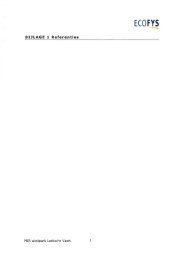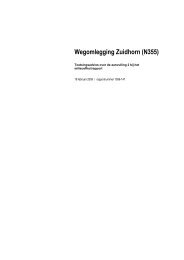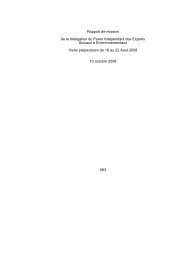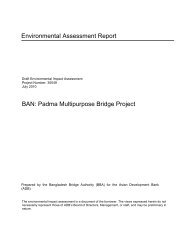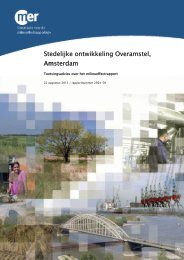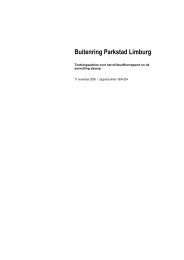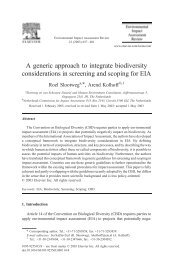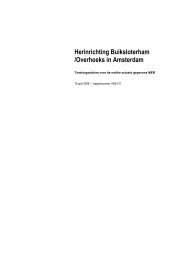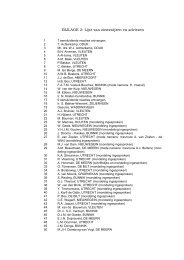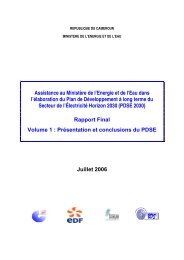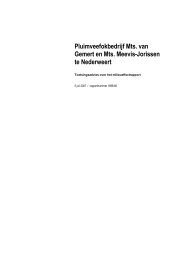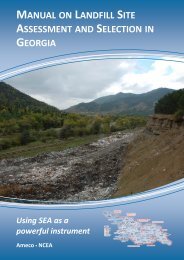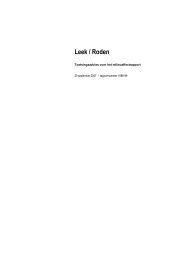Scoping Advice for the Dutch IWRM Support Programme Rwanda
Scoping Advice for the Dutch IWRM Support Programme Rwanda
Scoping Advice for the Dutch IWRM Support Programme Rwanda
Create successful ePaper yourself
Turn your PDF publications into a flip-book with our unique Google optimized e-Paper software.
3.3 Component 3: Catchment ManagementThe complete component title and description in <strong>the</strong> NCEA’s ToR reads as follows:Component 3: Rehabilitation and development of catchments and irrigation (West <strong>Rwanda</strong>).“Restore <strong>the</strong> Lake Kivu 12.000 ha catchment functions through investments in waterinfrastructure, terracing, tree planting etc. Based on <strong>the</strong> Water Resources Management Master Planand sectorial strategic plans <strong>for</strong> energy and food security, project plans will be elaborated <strong>for</strong> anintegrated approach to catchment management, marshland development, irrigation anddevelopment of hydropower resources. Investments in new irrigation systems with due regard <strong>for</strong>technical, social and environmental impact. This will result in 1000 ha <strong>for</strong> sustainable irrigation” 26Catchments in <strong>Rwanda</strong>Part of <strong>the</strong> Master Plan development process includes identification and subdivision of catchmentsin <strong>Rwanda</strong> in four levels. The Master Plan will <strong>the</strong>n include <strong>IWRM</strong> analyses of each catchment (Level1) and in some cases detailed studies and additional monitoring is being carried out at Level 2 or3. In <strong>Rwanda</strong> <strong>the</strong> following main catchment levels are identified 27 :- Level 0 - Nile Basin and <strong>the</strong> Congo basin- Level 1 – <strong>the</strong>re are 9 Level 1 catchments (2 <strong>for</strong> <strong>the</strong> Nile and 7 <strong>for</strong> <strong>the</strong> Congo)- Level 2 – <strong>the</strong>re are 20 Level 2 catchments (5 <strong>for</strong> <strong>the</strong> Nile and 15 <strong>for</strong> <strong>the</strong> Congo (proposeddivision, not yet <strong>for</strong>malised)- Level 3 – even smaller catchments of about 100 km2 (proposed division, not yet <strong>for</strong>malised)Management at catchment levelThe NCEA observed that <strong>the</strong> principle of catchment based <strong>IWRM</strong> is generally supported, also byo<strong>the</strong>r sectors. The Kigali workshop provided a clear signal from o<strong>the</strong>r sector departments that<strong>the</strong>y are waiting <strong>for</strong> <strong>the</strong> RWRD to define <strong>the</strong> playing field and boundaries <strong>for</strong> <strong>the</strong>ir developmentplanning. Institutional arrangements and clear in<strong>for</strong>mation about availability of water (now and infuture) are a first priority.At present <strong>Rwanda</strong> has a clear national set up and implementing organization <strong>for</strong> <strong>IWRM</strong>, asdescribed in <strong>the</strong> Water Law. Such administrative boundaries do not necessarily follow catchmentboundaries, as a catchment can include several smaller areas of various districts. This is acommon issue within <strong>IWRM</strong>, which needs special attention during <strong>IWRM</strong> implementation.The Water Law <strong>for</strong>esees management at catchment level through catchment committees that areto be set up. These committees will have <strong>the</strong> responsibility to identify and anticipate on waterrelated issues. It remains unclear who will have final decision taking authority in case of a conflictof interest related to water management: <strong>the</strong> district or <strong>the</strong> catchment committee. It also remainsto be seen whe<strong>the</strong>r <strong>the</strong> set-up as proposed by <strong>the</strong> Water Law allows <strong>for</strong> sufficient diversification ofinstitutional arrangements <strong>for</strong> each catchment, depending on specific issues in that area. For26 Description derived from NCEA’s ToR, see Appendix 127Consultancy services <strong>for</strong> development of <strong>Rwanda</strong> national water resources master plan (Progress report -1), SHER Ingénieurs-Conseils s.a., October 201219



